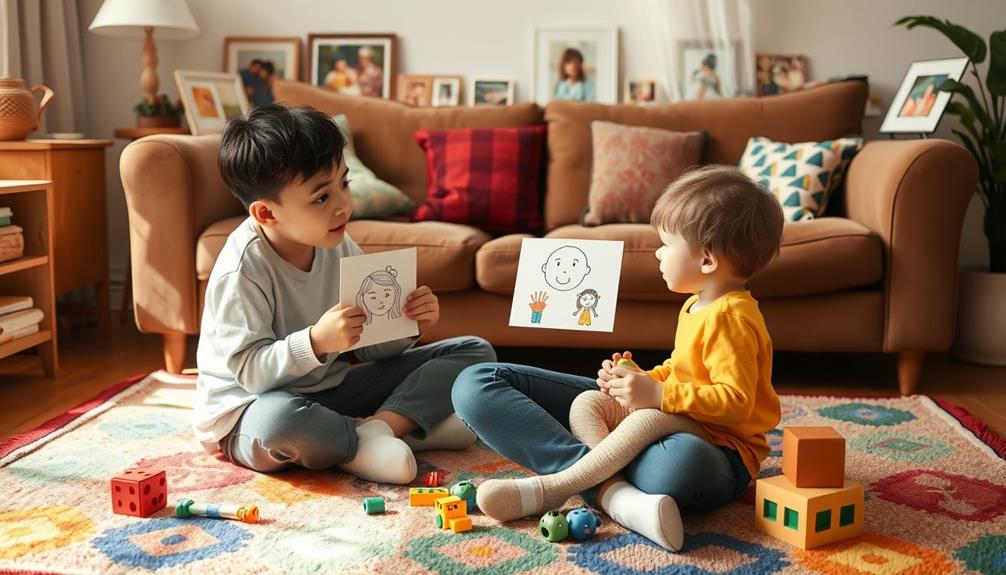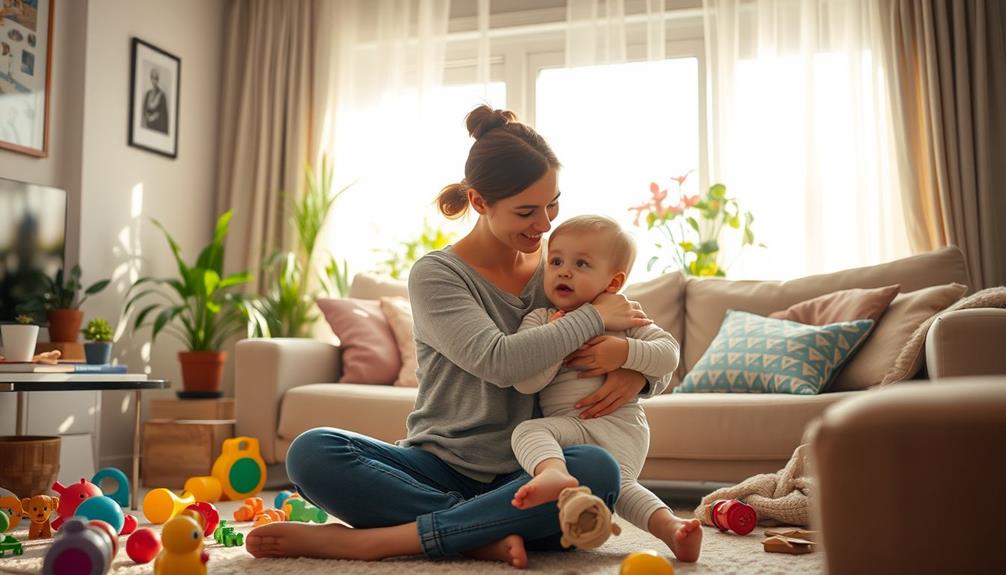Parenting with BPD can be tough, but several strategies can help you foster a supportive environment for your kids. Start by simplifying complex emotions for young children and encouraging open communication with teens. Establishing consistent routines brings stability, while mindfulness practices enhance your emotional regulation. Don't hesitate to seek professional support and engage in support groups to connect with others facing similar challenges. Encourage your children to express their feelings through creative activities, helping them understand their emotions better. By incorporating these strategies, you can enhance family dynamics and emotional well-being, paving the way for deeper insights on this journey.
Key Takeaways
- Establish predictable routines to create a sense of security and reduce anxiety for children.
- Utilize effective communication techniques to help children understand and express their emotions.
- Practice mindfulness and emotional regulation techniques to manage intense feelings and model healthy coping.
- Seek professional support, including therapists specializing in DBT, to enhance emotional stability and parenting skills.
- Join support groups to share experiences and gain strategies for parenting with BPD, fostering a sense of community.
Understanding BPD and Its Impact

Understanding Borderline Personality Disorder (BPD) and its impact on parenting is essential for fostering healthier family dynamics. BPD is marked by intense emotional instability, impulsive behaviors, and challenges in interpersonal relationships.
As a parent with BPD, you might face difficulties in regulating your emotions, which can lead to inconsistent parenting practices. This unpredictability may create an unstable environment for your children, making it hard for them to develop trust and secure attachments.
In addition, the disorder often co-occurs with other mental health issues, such as anxiety and depression, which can compound parenting challenges and affect family interactions. Research shows that children of parents with BPD are at a higher risk for emotional and behavioral issues. They often struggle with feelings of insecurity and may face attachment problems, which can affect their overall development.
Additionally, the transgenerational transmission of BPD means your children could have a considerable increased risk of developing the disorder themselves.
However, there's hope. Interventions aimed at improving your emotional regulation and promoting consistent parenting strategies can help mitigate these negative outcomes.
Communicating With Young Children

Effective communication with young children about BPD involves simplifying complex emotions into relatable concepts. You can frame your emotional struggles as a "feelings sickness" to help them grasp what you're experiencing. Since young children rely heavily on non-verbal cues, use facial expressions and tone of voice to convey your feelings. This helps them understand emotions better.
Encourage your kids to recognize and name their emotions. This practice fosters emotional intelligence and allows them to articulate their feelings. Reassure them that, as parents with BPD, you're actively working on improving your emotional health, and they are loved and supported despite the challenges.
Here's a simple table to illustrate feelings:
| Emotion | Feeling Face | Example Situation |
|---|---|---|
| Happy | �� | Playing with a favorite toy |
| Sad | �� | Losing a pet |
| Angry | �� | Sharing toys with a sibling |
| Confused | �� | Not understanding a game |
Utilize creative activities like drawing or storytelling to let your children express their thoughts and feelings in a safe and engaging way.
Explaining BPD to School-Aged Kids

When you explain BPD to your school-aged kids, it helps to compare it to a physical illness, like a cold, so they understand it affects emotional control.
You can also mention that some people may experience intense feelings similar to how certain zodiac signs may have heightened emotional responses, which can affect how they relate to others.
This connection can help them see that just like astrological compatibility influences relationships, emotional challenges can also play a role in family dynamics.
You can reassure them that seeking help from doctors or therapists is a positive step, showing that everyone can work together to feel better.
Encourage them to express their feelings and support their loved ones through creative activities, strengthening their relationships and understanding.
Understanding Feelings Together
Explaining borderline personality disorder (BPD) to school-aged children can feel challenging, but it's important to approach it with clarity and compassion. You can start by comparing BPD to a physical illness, helping them understand that it affects emotional control and isn't their fault.
Let them know that BPD is fundamentally a "feelings sickness," meaning it influences how you experience and manage your emotions. It's also critical to explain that many individuals with BPD experience intense emotional responses, making it even more important to address feelings openly and honestly common symptoms of BPD.
Encourage your children to express their feelings, reassuring them that their emotions are valid. This validation fosters an open dialogue about feelings, emphasizing that everyone has emotions that can sometimes be overwhelming.
Help them recognize and name their own feelings, which builds emotional awareness. Incorporate creative activities like drawing or writing, allowing them to illustrate their understanding and support.
These activities not only strengthen your connection but also cultivate empathy. You can introduce the idea of seeking help from doctors or therapists as a normal and positive step toward managing feelings and improving emotional health.
Seeking Help Together
Understanding that seeking help is a normal and positive step can make a significant difference for children grappling with a parent's borderline personality disorder (BPD).
It's important to explain BPD in a way they can relate to, comparing it to physical illnesses—this helps them understand it's a medical condition affecting emotional control and well-being.
Additionally, fostering a sense of curiosity about emotions can empower children to explore their feelings and ask questions, enhancing their understanding of the situation and promoting resilience in coping with challenges.
Curiosity and happiness can further encourage them to engage positively with their experiences.
Here are some ways to support your child through this process:
- Clarify Emotions: Reinforce that the intense feelings tied to BPD aren't their fault, easing guilt or confusion.
- Encourage Expression: Let them share their thoughts and feelings about BPD through creative outlets like drawing or writing, fostering open communication.
- Promote Teamwork: Emphasize that seeking help together—visiting doctors and therapists—shows a commitment to mental health and improvement.
- Provide Resources: Offer age-appropriate books or materials that illustrate BPD concepts, making the complexities of the condition relatable.
Talking to Teenagers About BPD

Talking to your teenager about BPD requires understanding their emotional responses and encouraging open communication.
It's important to be aware of their feelings and to use techniques like active listening to foster a supportive dialogue. They may have questions and concerns, so it's essential to create a safe space where they feel comfortable expressing themselves.
Understanding Emotional Responses
Managing emotions can be challenging, especially when a parent has Borderline Personality Disorder (BPD). Understanding emotional responses is essential for both you and your parent. It's important to remember that their intense feelings aren't your fault. Here are some key points to reflect on:
- Intense emotions can lead to misunderstandings, making it hard to connect. Children and teenagers are particularly vulnerable to these emotional fluctuations, which can affect their own emotional development and relationships with others. Engaging in key domains of development can provide insight into how these dynamics impact growth.
- You're not responsible for your parent's moods; guilt can cloud your relationship.
- Open dialogue about BPD's impact on daily life fosters understanding and support.
- Emotional validation strengthens family bonds—acknowledging feelings makes a difference.
It's imperative to reassure yourself and your parent that while BPD can complicate emotions, there are effective treatments like Dialectical Behavior Therapy (DBT). This therapy teaches skills for emotional regulation and improves interpersonal effectiveness.
Engaging in conversations about feelings can help you both navigate the complexities of your relationship. By focusing on understanding emotional responses, you can create a supportive space where both of you feel heard and valued.
Open Communication Techniques
When discussing BPD with teenagers, it's vital to create an open and honest atmosphere. Use clear, age-appropriate language to help them understand how the disorder affects emotional regulation. This approach aligns with the philosophical exploration of understanding self-identity, as it encourages deeper self-reflection on their experiences and emotions.
Make sure they know these feelings aren't their fault; this understanding can alleviate some of their confusion.
Encourage your teenager to ask questions and express their thoughts. This fosters an environment where they feel safe discussing their feelings and concerns about BPD. Validating their emotions is imperative; it shows you understand and support them, reducing feelings of isolation.
Emphasizing the importance of active listening can further enhance emotional connection and support.
Utilize open communication techniques like active listening. Reflect back what your teenager says to demonstrate empathy and deepen your emotional connection. This practice can help them feel heard and respected.
Reinforce the importance of ongoing treatment, like Dialectical Behavior Therapy (DBT), which requires family participation. Emphasizing your commitment to their recovery and emotional stability can help them feel more secure in their journey.
Emotional Regulation Techniques

Emotional regulation is essential for parents dealing with BPD, and several effective techniques can help. By practicing these strategies, you can manage your emotions, fostering a healthier environment for both you and your children. Engaging in mindfulness practices can enhance your ability to connect with your children, allowing for deeper moments of reflection and understanding, as seen in philosophical exploration.
- Mindfulness Techniques: Engage in deep breathing and meditation to recognize and manage your emotions in real-time. This awareness helps you respond rather than react.
- Regular Physical Activity: Incorporate exercise into your routine. Physical activity boosts your mood and reduces symptoms of emotional dysregulation, making it easier to handle daily challenges.
- DBT Skills: Utilize Dialectical Behavior Therapy skills, such as distress tolerance and emotional validation. These techniques help you navigate intense emotions and better support your children's needs.
- Journaling: Write about your feelings and experiences. Journaling offers insights into your triggers and patterns, enhancing self-awareness and emotional control.
Implementing these emotional regulation techniques can empower you to create a more stable and nurturing environment, allowing you to respond to your child's needs with greater compassion and understanding.
Establishing Routines and Consistency

Establishing routines creates a sense of security for your children, helping them thrive in an environment where expectations are clear. Predictable routines reduce anxiety and foster emotional stability, which is especially important when you have BPD.
Additionally, incorporating elements from the power of imagination can enhance your family's ability to cope with change and uncertainty. By maintaining consistency in daily activities like mealtimes and bedtimes, you not only enhance your children's development but also create a structured atmosphere that benefits everyone.
Implementing a regular schedule can help you manage your emotional fluctuations, providing a sense of control and predictability in your life. Children thrive on knowing what to expect; it encourages healthy coping mechanisms and helps them process emotions, especially in high-stress situations.
Incorporating mindfulness practices into your routines can further promote a calm environment, allowing both you and your children to manage emotions more effectively. This approach fosters positive interactions, making it easier to navigate challenges together.
Seeking Professional Support

When you're steering through the complexities of parenting with BPD, finding qualified therapists can make a significant difference.
These professionals can help you develop effective strategies for managing behavioral issues and provide tailored approaches to your unique challenges.
They can also help you connect with support groups, where you can share experiences with others facing similar challenges.
Seeking this professional support can enhance your parenting skills and improve your family's overall well-being.
Finding Qualified Therapists
Finding the right therapist for Borderline Personality Disorder (BPD) can feel overwhelming, but it's crucial for effective support. When you're looking for qualified therapists, you want to guarantee they've the right expertise.
Conducting thorough checks on a therapist's background can help identify any potential red flags and guarantee they've a history of providing effective care, similar to how employers conduct background checks for safety.
Here are four key steps to guide you:
- Specialization: Seek therapists who specialize in Dialectical Behavior Therapy (DBT), the most recognized and effective treatment for BPD.
- Credentials: Verify their credentials and experience. Check their licensing, certifications, and years of practice in mental health.
- Therapist Directories: Use resources like the Psychology Today directory or BPD Central website. These platforms help you find therapists who explicitly list BPD as a specialty.
- Initial Consultation: Many therapists offer an initial consultation. This is your chance to assess their approach and compatibility before committing to ongoing sessions.
Finding qualified therapists is crucial for your journey. The right support can make all the difference in managing BPD and nurturing your parenting skills.
Utilizing Support Groups
Support groups offer a valuable opportunity for parents with BPD to connect with others who share similar experiences. By participating in these groups, you can find a safe environment to share your challenges and receive emotional validation, which can greatly reduce feelings of isolation and stress.
Listening to others' stories can remind you that you're not alone in your journey. Additionally, engaging in these groups can help you discover effective cold medications overview that may alleviate stress-related symptoms, allowing you to focus on parenting.
In support groups, you'll learn effective coping strategies and parenting techniques from peers who've faced similar situations. Research shows that involvement in these programs can lead to better emotional regulation and increased confidence in your parenting skills.
Many support groups are facilitated by mental health professionals, providing you access to expert guidance and tailored resources.
Engaging in support groups not only fosters a sense of community but also enhances your overall mental health and well-being. This improvement is vital for building a stable and nurturing environment for your children.
Building a Support Network

Creating a solid support network is essential for parents maneuvering the challenges of BPD. Building this network involves connecting with family, friends, and community resources to share the responsibilities and emotional burdens of parenting.
Here are some key components to take into account:
- Support Groups: Join groups specifically for parents with BPD. They provide a safe space to share experiences and receive validation.
- Mental Health Professionals: Engage with therapists or counselors who understand BPD. They can offer tailored guidance and strategies for your unique parenting needs.
- Online Forums: Utilize social media and online platforms to find peer support. Exchanging coping strategies with fellow parents can be incredibly uplifting.
- Reliable Caregivers: Establish a network of trusted babysitters or family members. This can alleviate stress and provide necessary breaks, benefiting both you and your child.
Mindfulness and Self-Care Practices

Incorporating mindfulness and self-care practices into your daily routine can greatly impact your parenting journey. Mindfulness techniques, like meditation and deep breathing exercises, can considerably reduce emotional dysregulation, creating a more stable environment for you and your children. By making these practices a priority, you improve your emotional awareness, allowing you to recognize and manage your feelings before they affect your parenting.
Engaging in regular self-care activities—whether it's exercise, a hobby, or simply taking time for yourself—helps maintain your emotional well-being and reduces stress. This, in turn, enhances your emotional regulation, fostering healthier interactions with your kids.
Remember, practicing self-compassion is essential; it allows you to acknowledge your struggles without judgment, further promoting a calm and nurturing atmosphere.
Research shows that mindfulness-based interventions can enhance your parenting skills, leading to more consistent and responsive behaviors when your children express their needs. By committing to these mindfulness and self-care practices, you not only support your emotional development but also create a loving and nurturing environment that benefits your children's emotional growth.
Encouraging Emotional Expression in Children

Recognizing and nurturing emotional expression in children is essential for their healthy development. By helping your child identify and articulate their feelings, you're not only enhancing their emotional intelligence but also fostering a supportive family environment.
Here are some effective strategies to encourage emotional expression:
- Teach feeling words: Encourage your child to use specific words for their emotions, like "frustrated" or "excited," during discussions. This empowers them to articulate feelings clearly.
- Engage in creative activities: Activities like drawing or storytelling allow your child to express emotions in a non-threatening way, making it easier for them to understand their feelings.
- Model emotional expression: Show your child that it's okay to share feelings, even as a parent with BPD. Your openness normalizes emotional discussions and strengthens their communication skills.
- Create a safe space: Guarantee your home is a supportive environment where your child feels safe to express themselves. This reduces the risk of emotional suppression and promotes mental well-being.
Conclusion
Steering through parenting with BPD is a journey filled with ups and downs, but you're not alone. By fostering open communication, practicing emotional regulation, and building a strong support network, you can create a nurturing environment for your kids. Remember, every small step you take today plants a seed for their emotional resilience tomorrow. So, embrace the chaos and celebrate the moments; after all, it's through the storm that rainbows often emerge. Your efforts truly matter.









